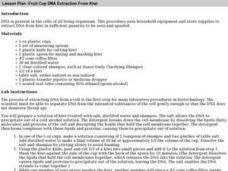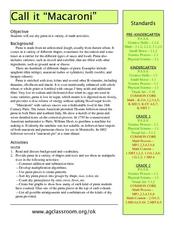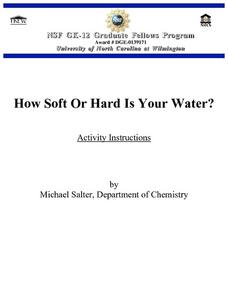Curated OER
Fatty Acids For Soap Making
Students titrate a sample of fatty acids with standardized sodium hydroxide solution. From the amount of base needed for neutralization and the mass of sample used for titration, the apparent average molar mass of the sample is...
Curated OER
The Art of Soap Making
Here is a nice, clean wrap-up instructional activity for your chemistry class when they are studying chemical reactions . They experiment with different oils to make soap. To make it more fun, they are to imagine that they are part of a...
Curated OER
Beta-Oxidation of Unsaturated Fatty Acids
Students work in small groups to determine the amount of protein contained in an unknown sample. They conduct the experiment, plot the points of absorbency, and present their findings to the class.
Curated OER
Reading Labels For Fat Types
Students analyze a variety of cooking oils to determine the amount and types of fats included in each.
Curated OER
Food or Fuel?
Pupils describe the process of transesterification utilizing chemical formulas. They construct and compare models of chemical structure of the substances involved in biodiesel production such as: alcohols, alkenes, alkanes, alkyls,...
Curated OER
Fruit Cup DNA Extraction From Kiwi
Students extract DNA from kiwi using household equipment and supplies.
Curated OER
Genetically Modified Food (GMF)
Explore genetically modified foods through various experiments. In this biology lesson, students discuss the safety issues related to GMF's. They conduct a PCR analysis to identify the presence of genetic modification.
Curated OER
Call it "Macaroni"
Who knew there were so many fun educational opportunities featuring pasta? Scholars read a brief informational text about the history of pasta (note that "macaroni" is spelled two different ways, so address this if kids are reading...
Curated OER
It's in the Label - The Food Label
Young scholars examine the fat content in their diet and how advertising affects their eating habits. In this nutrition and advertising lesson, students analyze pizza and how to make it healthier. Young scholars recognize the...
Curated OER
The Optimization of Food
Young scholars discuss nutrition and how to make better choices with food. In this algebra and nutrition instructional activity, students discuss the way the body process food and the importance of nutrition for our cells. They discuss...
Curated OER
Snack Sack
First graders, after exploring agricultural products that can be considered snack foods, experience the concepts of ratio and probability. They analyze and record their class experience after dealing with the following snacks: peanut...
Curated OER
Our Choices Matter: What You Eat
Students will record their food choices for one week, noting calories, protein and vitamin content of foods using a given USDA website. Students will discuss whole class the important of proper nutrition and its role, and what happens...
Curated OER
How Soft or Hard is Your Water?
Young scholars test samples of water to determine how a chemical water softener affects water's ability to form suds. After collecting their data and analyzing their results, students answer follow-up questions about their lab.
Curated OER
Fats
Students are introduced to the characteristics of fats and their function in the body. In groups, they make a reduced fat recipe of chicken fingers and discuss other ways to reduce fat in their diet. To end the lesson, they identify...
Curated OER
PICKING PEANUTS
Students create sentences, using words printed on pictures of peanuts. They are explained that the peanut is not really a nut, but a legume, related to beans and peas. Students are also told that the first peanuts grew in Brazil. They...
Other popular searches
- Fatty Acids and Inflammation
- Trans Fatty Acids
- Fatty Acid Lipids
- Unsaturated Fatty Acids
- Saturated Fatty Acid
- Omega 3 Fatty Acid
- Lipids Fatty Acid Glycerol
















